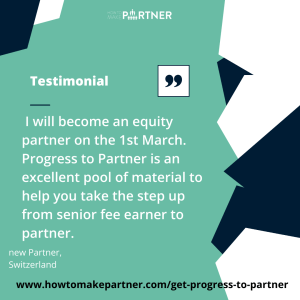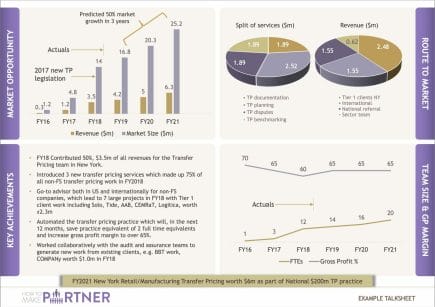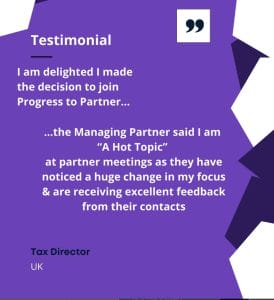Given how hard it is to make partner in a Big 4 firm, you can be forgiven for making this mistake. Creating the perfect Big 4 Business Case for partner (or director) will take significant time. However, this mistake scuppered one of our client’s admission to the partnership last year. Read on for more details.
You need to get feedback on your Big 4 Business Case for partnership
Everyone says you should not write your Business Case in a Big 4 firm in isolation. Absolutely true. You’ll hear us telling you this as well. If you are to maximise your chances of making partner in a Big 4 firm, you need to make sure that you have consulted with many influential partners and stakeholders about your Business Case for partnership.
If you are in a Big 4 firm, your Big 4 Partner Business Case will be something that your partners have already agreed upon. The only thing that hasn’t been agreed upon is the person they want to deliver this Business Case. This means you have lobbying amongst your partners to ensure that you are seen as the right person to deliver the promise of this Big 4 Partner Business Case.
The final version of your Business Case for partnership will typically be a long document; think 50+ pages. This final version is often a mixture of your Business Case and the evidence that you are the right person to implement it. But also your Personal Case. I.e. how you are already demonstrating that you are a great role model for the values of your Big 4 firm AND are acting at the level required of a junior Big 4 partner. All Big 4 Business Cases typically follow a standard type of format. Download my sample Partner Business Case template here to determine what you must demonstrate in your Big 4 Partner Business Case.
Don’t crowdsource your Big 4 Partner Business Case
The problem is that when you show your Big 4 Business Case for partner (or director) to anyone in your firm, they will have an opinion on it. They, normally, will also want to be as helpful as possible. This means they will come up with changes to how you structure your Big 4 Partner Business Case, suggest words you may or may not like to use, and other pertinent pieces of feedback. The problem is the more you consult, the more feedback you get. If you then diligently make all the changes as suggested, you end up with a Big 4 partner Business Case that is no longer your own. It’s taken on a life of its own and became a turgid document that starts to hide your light underneath a very big shadow.
Your Big 4 Business Case needs to be your own
By all means, go out and seek feedback on your Big 4 Business Case for partner (or director). It’s really important that you still do this but remember to retain editing rights for your document. You need to ensure that your document’s message remains succinct, punchy and crisp. Don’t feel as if you have to take on board every bit of feedback about your business case. The document needs to be owned by you. Always make sure that with your Business Case it does the following:
- reads well and ‘hangs together’ well
- is structured so the key messages are clear and easy to understand
- every word has fought for its place
- minimises jargon and waffle
- tells a clear and evident story about the commercial benefit to making you up to partner
 For advice and guidance on how to survive and thrive in your firm sign up to my weekly newsletter here and you’ll find out what you need to be working on in your career development (and how to make the time for your career development) to progress your career in your firm. Or check out my Progress to Partner Academy
For advice and guidance on how to survive and thrive in your firm sign up to my weekly newsletter here and you’ll find out what you need to be working on in your career development (and how to make the time for your career development) to progress your career in your firm. Or check out my Progress to Partner Academy
Use a Talk Sheet to help your Business Case be succinct and punchy
Chapter 11 of Poised for Partnership focuses on how to create, write and then pitch your Business Case – regardless of whether it is a Big 4 partner Business Case or a Business Case for a law firm or different size or type of firm. The basics of any Business Case for partner are the same. I.e. demonstrate there is a commercial benefit for implementing the Business Case, and determine that I am the right person to implement the Business Case. A good way to help articulate the promise of your Big 4 Partner Business Case, particularly when you are gaining advocacy from partners is to use a Talk Sheet.
Your Talk Sheet is a great way to zoom in on what matters with your Big 4 Partner Business Case. It also stops your Big 4 Partner Business Case from being crowdsourced. We first came across the concept of a Talk Sheet when working with a US-based future Big 4 partner. Since then, many firms have liked the Talk Sheet concept and started asking their future partners to use it.
So what is a Talk Sheet?
 It’s a one-page document which concisely summarises your Partner Business Case. It’s often 4-5 visuals with a small bit of text.
It’s a one-page document which concisely summarises your Partner Business Case. It’s often 4-5 visuals with a small bit of text.
See the image on the right for an example of a Talk Sheet.
This Talk Sheet was based upon a Talk Sheet in which we helped someone step up to Partner in their Big 4 firm.
Wouldn’t it be helpful if you could use this professionally designed Talk Sheet as a template for your own version of this? It would save you so much time! The Talk Sheet is just one of the many resources in our Progress To Partner membership site. You can download the Talk Sheet template for free here.
Here is how Progress To Partner Academy will help you with your Business Case for partner?
Progress to Partner Academy will give your the knowledge AND confidence to fly through this final step up to partner.

It’s like a Netflix for your career in the professions. Find what you need to watch or read at the time you need it. Within the site, you’ll find over 150+ courses, videos, checklists, templates and plans to help you progress your career to partner. Amongst the many curated resources (no more unnecessary scrolling or searching), you’ll find:
- 14 self-study courses including How to Delegate like a Pro and how to win work for your firm and “How to Build a Cast-Iron Business Case for Partner”
- A section on the Partnership Admissions process with guides and recordings to help you find your way through the process with your sanity intact.
- Recordings and checklists on how to ace your partner panel interview
- On-demand courses on how to win the right sort of clients
- Proven advice on how to still do the day job and find the time to get through the Partner Track process








